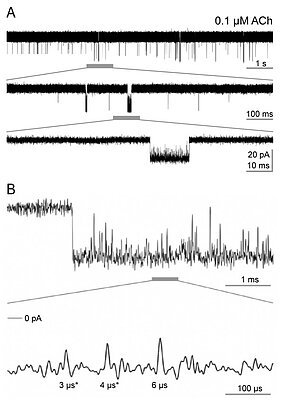Different Time Courses of Mono- and Bi-Liganded Bursts of Channel Openings of Adult nAChR Molecules Formed by the Reactions of Transmembrane Regions
11/11/2024Different Time Courses of Mono- and Bi-Liganded Bursts of Channel Openings of Adult nAChR Molecules Formed by the Reactions of Transmembrane Regions
Dmitrij Ljaschenko†, Martin Pauli†, Achmed Mrestani 2,3 , Josef Dudel, Manfred Heckmann
Cells 2024, 13(24), 2079; https://doi.org/10.3390/cells13242079
We recorded transmembrane currents through single nicotinic acetylcholine receptors (nAChRs) in cell-attached patches at high temporal resolutions from cultured and transiently transfected HEK 293 cells. Receptor activation was elicited by acetylcholine (ACh) or epibatidine (Ebd) at concentrations ranging from 0.01 to 100 µM, binding to one (Rαδ or Rαε) or both extracellular ligand binding sites (Rαδ+αε). Agonist binding to Rαδ resulted in very short openings with mean durations of (τo1 < 5 µs), while the binding to Rαε produced short (τo2 = 37 µs) and intermediate openings (τo3 = 187 µs). Binding at both sites (Rαδ+αε) generated long openings (τo4 = 752 µs). All durations are noted in brackets since missed closures could shorten the results. Mono-liganded bursts were elicited at 0.01 µM ACh or Ebd, lasted less than a millisecond, displayed the typical current amplitude, and were interrupted by frequent microsecond-scale closures (µBs) that often did not reach the zero current. In contrast, bi-liganded bursts exhibited classical full amplitudes and long open states lasting up to several milliseconds, interspersed with rare µB closures of a similar duration to those observed in mono-liganded bursts.






